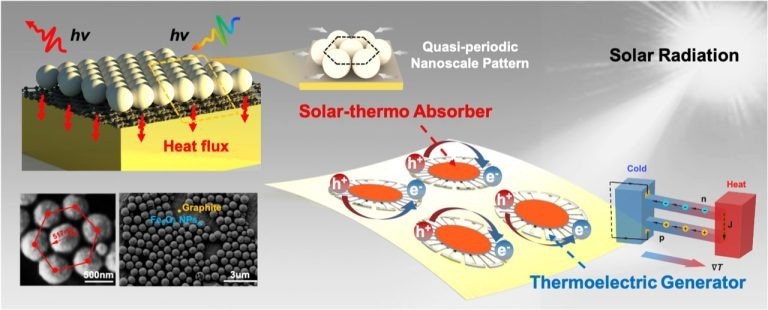A promising eco-friendly energy harvesting method called solar-thermal technology has a crucial role to play in resolving the crisis of fossil fuel energy.
 These images show the device’s solar-thermal conversion (left) and solar thermoelectric harvesting (right). Image Credit: Zifu Xu.
These images show the device’s solar-thermal conversion (left) and solar thermoelectric harvesting (right). Image Credit: Zifu Xu.
The newly developed technology helps convert sunlight into thermal energy, but it becomes difficult to suppress energy dissipation while the high absorption has been maintained. The currently available solar energy harvesters that depend on micro- or nano-engineering do not have enough flexibility and scalability. Also, a novel plan is required for high-performance solar light capture while concurrently reducing costs and easing fabrication.
In the journal APL Photonics, from AIP Publishing, scientists from Harbin University, Zhejiang University, Changchun Institute of Optics, and the National University of Singapore have developed a solar harvester with improved energy conversion capabilities.
A quasiperiodic nanoscale pattern has been employed by the device, which implies that most of it is a constant and alternating pattern. At the same time, the leftover portion consists of random defects (dissimilar to a nanofabricated structure) that do not impact its performance. Also, the scalability of the device has been increased by loosening the strict needs on the periodicity of the structure considerably.
The fabrication process employs self-assembling nanoparticles, which develop an orderly material structure depending on their interactions with particles in the vicinity without any external instructions.
The thermal energy that was harvested using the device could be converted to electricity using thermoelectric materials.
Solar energy is transferred as an electromagnetic wave within a broad frequency range. A good solar-thermal harvester should be able to absorb the wave and get hot, thereby converting solar energy into thermal energy.
Ying Li, Study Author, Zhejiang University
Li added, “The process requires a high absorbance (100% is perfect), and a solar harvester should also suppress its thermal radiation to preserve the thermal energy, which requires a low thermal emissivity (zero means no radiation).”
For such goals to be achieved, a harvester is generally a system having a periodic nanophotonic structure. However, owing to the rigidity of the pattern and high fabrication costs, the scalability and flexibility of these modules could be restricted.
High absorbance (above 94%) and suppressed thermal emissivity (below 0.2) have been achieved by their quasiperiodic nanophotonic structure. Also, while subjected to natural solar illumination, the absorber features a quick and considerable temperature increase (greater than 80 °C).
Unlike previous strategies, our quasiperiodic nanophotonic structure is self-assembled by iron oxide (Fe3O4) nanoparticles, rather than cumbersome and costly nanofabrication.
Ying Li, Study Author, Zhejiang University
A flexible planar solar thermoelectric harvester has been constructed by the group based on the absorber, which attained a considerable sustaining voltage of more than 20 millivolts per square centimeter.
They anticipate it to power around 20 light-emitting diodes per square meter of solar irradiation. This strategy could act as low-power density applications for highly flexible and scalable engineering of solar energy harvesting.
We hope our quasiperiodic nanophotonic structure will inspire other work. This highly versatile structure and our fundamental research can be used to explore the upper limit of solar energy harvesting, such as flexible scalable solar thermoelectric generators, which can serve as an assistant solar harvesting component to increase the total efficiency of photovoltaic architectures.
Ying Li, Study Author, Zhejiang University
Journal Reference:
Xu, Z., et al. (2022) Scalable selective absorber with quasiperiodic nanostructure for low-grade solar energy harvesting featured. APL Photonics. doi.org/10.1063/5.0135193.